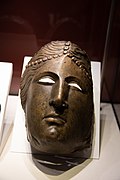Castra of Cincșor


- Castra of Feldioara
- Castra of Hoghiz
 Romania
Romania National Historical Monument
National Historical MonumentThe castra of Cincșor was a fort in the Roman province of Dacia in the 2nd and 3rd centuries AD[1][2] and part of the frontier system of the Limes Alutanus.

Location
The ruins of this cohort fort are located about two km east of the village Cincșor, commune Voila, and about one km north of the river Olt in the corridor "Burgstadt". In ancient times, it probably had the task of monitoring the movement of goods on the Olt and the Cincu Pass to the north.
Finds
During the archaeological excavations of the years 1974/1975 and 1979 to 1992, trenches were dug determining the location of the fort. Two construction phases could be distinguished: there was initially a wood-and-earth storage facility, which was later replaced by a stone fort. The stone fort had a rectangular ground plan and on the west side was a defensive wall and four ditches. The date is uncertain, but epigraphic finds could identify the Cohors II Flavia Bessorum as the stationed unit.
A funerary inscription for a Roman military official, L. Carvilius Rusticinus, was discovered near the fort.[4]
In 1986 an excavator discovered a bronze parade mask nearby the fort, in the area of the reservoir lake. The mask depicts a woman's head. It has 24.5 cm height, 17 cm width and 14.5 cm depth.[5]
Exhibition
The archaeological finds can be found in the Muzeul Țării Țării[6] in Făgăraș and in Muzeul Județean Brașov[7] in Brașov.
Monument protection
The archaeological site and in particular the fort are protected as historical monuments.
-
 Parade mask found near the fort
Parade mask found near the fort -

-

See also

External links
- Roman castra from Romania - Google Maps / Earth Archived 2012-12-05 at archive.today
- ARCHAEOLOGICAL REPERTORY OF ROMANIA Archive Of The 'Vasile Parvan' Institute Of Archaeology - Site Location Index, page 10 Archived 2012-09-28 at the Wayback Machine
- details?articleID=2948 MONUMENTE. Masca unui calaret roman
Notes
- ^ a b c d "42325.01". National Archaeological Record of Romania (RAN). ran.cimec.ro. 2009-05-13. Archived from the original on 4 March 2016. Retrieved 5 January 2013.
- ^ a b c d "Lista Monumentelor Istorice 2010 ("2010 List of Historic Monuments")" (PDF). Monitorul Oficial al României, Partea I, Nr. 670 ("Romania's Official Journal, Part I, Nr. 670"), page 578. Ministerul Culturii şi Patrimoniului Naţional. 1 October 2010. Archived from the original (PDF) on 10 June 2012. Retrieved 5 January 2013.
- ^ "Cincsor". STRATEG MAPS: Defensive strategies and trans-border policies at the Lower Danube in Roman Antiquity (An interdisciplinary project). Archived from the original on 14 May 2012. Retrieved 5 January 2013.
- ^ a b c d e f g h i Carol-Opriş, Ioan; Raţiu, Alexandru; Stoian, Gabriel, "Stadiul cercetării siturilor din jud. Braşov şi Covasna ("Stage of the research in Braşov and Covasna Counties")", Strateg.org.ro, Raport ştiinţific Privind Derularea Proiectului Strategii Defensive şi Politici Transfrontaliere: Integrarea Spaţiului Dunării De Jos în Civilizaţia Romană (STRATEG) ("Scientific Report on the Progress of the Project "Defensive Strategies and Border Policies: Integration of the Lower Danube Region in Roman Civilization (STRATEG)""), pp. 37-, www.academia.edu, retrieved 5 January 2013
- ^ "Comorile Făgăraşului". 24 July 2013.
- ^ Official website of the museum (Romanian), retrieved on the 4th day of the excavation. January 2019
- ^ Official website of the museum (Romanian), accessed on January 4, 2019
- v
- t
- e
- (Hoghiz) ?
- (Cincșor)
- (Feldioara)
- Caput Stenarum
- Pons Vetus
- Praetorium
- Arutela
- (Rădăcinești)
- Buridava
- Castra Traiana
- Pons Aluti
- Rusidava
- Acidava
- Romula
- (Slăveni)
- (Islaz)
- Cumidava
- (Drumul Carului)
- (Rucăr)
- (Voinești)
- Jidava
- (Purcăreni)
- (Albota)
- (Săpata de Jos)
- (Fâlfani)
- (Izbășești)
- (Urluieni)
- (Crâmpoia)
- (Gresia)
- (Roșiorii de Vede)
- (Salcia)
- (Băneasa)
- (Putineiu)
- Resculum
- (Gilău)
- (Buciumi)
- Optatiana
- Largiana
- Certiae
- (Jac)
- Porolissum
- (Tihău)
- Samum
- Arcobara
- (Livezile)
- (Orheiu Bistriței)
- (Brâncovenești)
- (Orheiu Bistriței)
- (Brâncovenești)
- (Gurghiu)
- (Călugăreni)
- (Sărățeni)
- Praetoria Augusta
- (Odorheiu Secuiesc)
- (Sânpaul)
- Angustia
- (Olteni)
- (Boroșneu Mare)
- (Cristești)
- (Hoghiz)
- (Băile Homorod)
- (Ocland)
- (Baraolt)
- Rupes
- (Brașov)
- Cumidava













